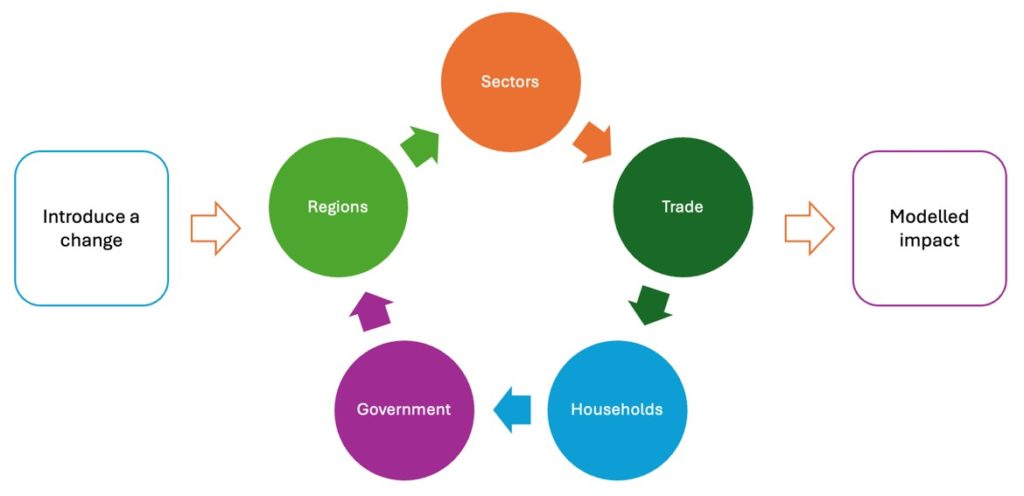
In a new series of blogs, we will be reviewing the current and historical work of City-REDI and WMREDI. In the first blog from this series, we look at SEIM-UK, an economic model that City-REDI has used to assess the economic impact of the 2022 Commonwealth Games, the impact of Council tax cuts, and help us to understand the way the UK economy works.
An economic model of the UK
Socio-Economic Impact Model for the UK (SEIM-UK) is a multi-region input-output model that is a powerful tool for evaluating changes in the national or regional economy.
But what does that mean? An economic model is a simplified representation of reality. It uses mathematical equations and logical relationships to describe economic processes and predict outcomes. In the case of SEIM-UK it provides a highly detailed picture of the UK economy revealing the inter-relationships between 30 industrial sectors, 41 UK regions (NUTS-2 classification), foreign trade flows and an increasing array of household characteristics at the NUTS-1 level.
This allows our researchers to forecast future economic activity, analyse the structure of the West Midlands economy or provide policy analysis by evaluating the potential effects of government policies, like tax changes.
The SEIM-UK simplified:

Collaboration
So how did this model come about? City-REDI teamed up with Professor Geoffrey Hewings, from the University of Illnios Urbana-Champaign and Professor Kurt Kratena, from the Centre of Economic Scenario Analysis and Research (CESAR) who helped to develop the model along with Professor Raquel Ortega-Argiles, previously at City-REDI but now working for the Productivity Institute and also Assistant Professor Andre Carrascal, formerly of City-REDI but now based at the University of Oviedo.
The project is currently led by Dr Matt Lyons and Dr Huanjia Ma, Research Fellows at City-REDI.
Research using SEIM-UK
City-REDI has used the SEIM-UK to undertake research in a variety of ways:
Understanding how the UK economy works
Fundamental to the City-REDI vision is providing high-quality evidence to help address longstanding issues that blight the UK economy. This involves diagnosing problems in the UK economy but importantly offering solutions.
The ‘North/South divide’, the concept of ‘left behind places’, and the pursuit of ‘inclusive growth’ are all related to the entrenched issue of regional inequality.
The SEIM-UK is a powerful tool for understanding how the UK economy works, and in turn, can perpetuate regional inequalities. In a 2022 publication, Professor Andre Carrascal-Incera and Professor Geoff Hewings used SEIM-UK to understand the flows of incomes through the UK economy. The authors found that while there are only modest changes in the aggregate income propagation by region the accumulation of income is dominated by London and to a lesser extent other major metropolitan regions. Put simply, it provides evidence that incomes generated in peripheral regions flow to already prosperous parts of the UK.
Understanding these fundamentals of the UK economy allows us to ask, how can these inequalities be addressed? How can we achieve ‘levelling up’? One route to closing these gaps is to solve the productivity puzzle in UK regions through investment in R&D. In a 2024 working paper by Huanjia Ma, Raquel Ortega-Argilés and Matt Lyons the SEIM-UK was used to model the impact of increasing public R&D spending in regions. The paper found that increasing R&D investment in those areas with the least has the potential to address these inequalities without damaging national competitiveness. The findings of the paper are discussed in a blog hosted by Research Professional News.
Understanding the Local Economy: The Birmingham Commonwealth Games 2022

In 2022, Birmingham held the Commonwealth Games. The games brought the attention of the world to the city and the region, with over 1.5 million people buying tickets for the games as well as being streamed on the BBC a record-breaking 57 million times. It showed off Birmingham at its best, as a dynamic and exciting city, and made people want to visit the region.
In August 2022, Matt Lyons published “An early assessment of the economic impact of the Birmingham Commonwealth Games” in collaboration with the University of Strathclyde. The research used the Socio-Economic Impact Model for the UK (SEIM-UK) to assess the economic impact of the Games and estimated that it would lead to an increase in output of £140-£208 million, an increase in GVA by £68-£101million and create between 1,893 and 2,814 jobs (FTE). The work was well received and Matt was called upon for a series of news stories about the Commonwealth Games, providing economic commentary on whether Birmingham should hold the games again for the Guardian, for CTV Calgary on whether the region should go ahead and host the Games, and more recently in the Dispatch, discussing whether Birmingham should bid for the Olympics.
The SEIM has been used to address a range of other topics relating to the local economy:
- Understanding the structure of the West Midlands economy
- The impact of COVID-19 on the regional economy and on the Midlands automotive sector.
- Understanding the labour market impact of expanding child care support
- The impact of proposed cuts to Civil Service jobs in 2022
What next for the SEIM-UK Project?
The SEIM-UK has seen significant developments since its inception. The most recent developments allow us to answer new questions about how policy changes and shocks to the economy could impact the economy, environment, people and places.
Economy
The SEIM-UK has undergone significant developments to allow for the evaluation of shocks to different parts of the economy and with many more variables than were initially included. These developments allow us to provide forecasts out to 2040, evaluate changes in tax policies, estimate the impact of price shocks, understand the impact of changes on total factor productivity and many more. In short, we can do more than ever with a more accurate model.
Environment
Policymakers at the national, regional and city levels are increasingly pursuing aggressive emissions reduction targets. Economic activity produces emissions, some activities more than others and these activities are distributed across different regions. We plan to develop novel techniques to understand what the regional emissions picture looks like and how policies to reduce emissions could unfold across space.
People
The recent disaggregation of households within the UK economy led by Dr Huanjia Ma means the distributional impacts of changes in the economy can now be modelled. An example of this can be found in the Policy Briefing: ‘Addressing the Local Authority Financial Crisis’. The briefing demonstrates the impact different policy options have on different household income groups. The analysis found tax rises to be the least regressive option.
Places
A central issue in the UK’s regional economic problem is ensuring the right skills are in the right places. With new developments to better understand the regional labour market, we can show how big investments in places can lead to skills shortages, and how to address them.
The SEIM-UK is central to City-REDIs ability to generate evidence to evaluate projects, model different policy options, and model disasters or other unexpected upsets. If you want to better understand the UK economy – don’t hesitate to get in touch.
This blog was written by Dr Matt Lyons, Research Fellow at City-REDI, University of Birmingham.
Disclaimer:
The views expressed in this analysis post are those of the author and not necessarily those of City-REDI / WMREDI or the University of Birmingham.
